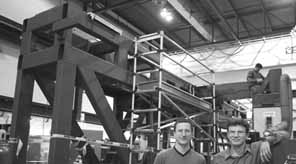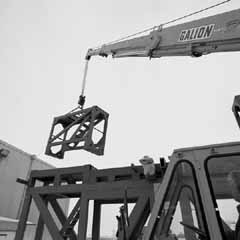 |
|
The Big Picture by Mike Perricone
But quarks, neutrinos, antiparticles--those impossible things are too small to be seen. Tom Diehl and Dmitri Denisov have to think about an impossible thing that's almost too big to believe. It's called the End Muon System truss, and it's major part of the Muon System, the largest single component in the upgrades to the DZero detector for Run II of the Tevatron. Actually, there are two of these deceptively simple-looking trusses, each 40 feet by 40 feet and weighing 35 tons. They're too big to be built in the DZero assembly hall. Diehl must get both of them assembled, disassembled, moved, reassembled and put into niches where a non-physicist would swear they could never fit--especially after Denisov finishes hanging 1,600 scintillation counters and 2,200 mini-drift tubes, accompanied by 17,600 wires, onto each truss. They also must complete this project six weeks sooner than they planned--in August instead of October. The ultimate goal is to have the entire building-sized detector ready to roll into the collision hall with a hard and fast deadline of March 1, 2001 for the beginning of Run II. "We had some contingency time in the previous schedule," said Diehl. "Moving up the schedule certainly removes that contingency time." "It was a short-term notice for us," said Denisov, "but there are many advantages for DZero to do it this way." Completing and installing the trusses at the north and south ends of the 5,000-ton DZero assembly, including their detectors and electronics, frees up more time for installing the silicon vertex detectors that comprise the heart of what is essentially a reinvented detector. Run II will mark the first time DZero operates with a solenoid magnet and with the tiny, intricate silicon vertex detectors surrounding the collision area. "I like the irony that we're changing the schedule for the largest part of the detector, the Muon System, to help the installation of the smallest detectors in the experiment, the silicon vertex detectors," Diehl said. "Moving up our schedule gives the silicon guys six more weeks to finish their jobs. This is a big jigsaw puzzle, and I don't think anything like it has been done before in particle detectors." As with any project this size at Fermilab, Diehl and Denisov are the point guys with too great a number of people involved to provide a complete list. The truss frames were built and welded in the Meson Assembly area by Don Carpenter's technical crew, with critical contributions by Dave Erickson and Jerry Judd. The top of the frame looms above the roof of the low, flat assembly building. Ernie Villegas of engineering and technical teams did the design work on the trusses, and Delmar Miller is in charge of the final assembly at DZero and testing of the big shielding pieces that will also fit into the trusses, which provide frames for detectors, readout electronics and shielding. The project follows these steps: The four sub-assemblies of each frame are built: full-width structures on top and bottom, smaller connecting structures on the sides. The bottom frame is the biggest and heaviest component, weighing almost 25 tons. It has to be strong enough to support nearly 100 tons of shielding in addition to the detector components. And those 100 tons of shielding must be movable, to allow access to the center of the detector. The sub-assemblies are loaded by a special forklift onto an 18-wheeled flatbed trailer, and brought to the hardstand outside Lab F. There the four components are bolted together, with the help of a crane truck rented for the job.
Once surveyed, the truss is taken apart, and trucked to the DZero assembly hall. The shielding blocks will be loaded onto the base. The toroid magnets at the ends of the big detector will be moved out of the way, as will large segments of the adjacent cryo system, clearing space for the truss components to be moved by overhead crane and lowered into place for final assembly. Then the scintillator and mini-drift tube detectors will be installed. Because of the numbers of detector components the trusses will hold, they must be precisely measured and aligned when they are first assembled. "When we put all the detectors onto this big frame," Diehl said, "we have to make sure they don't bump into each other and get into each other's way." Enter John Greenwood and his digital camera, called the "V-Star." The $70,000 unit uses CCD technology, and records extremely high-resolution images (6.3 megapixels, about 20 to 30 times the resolution of most CCD cameras) onto a hard drive that pops out of the camera and into a desktop computer. The camera is one of about a dozen or so in existence. "It's already paid for itself with the time we've saved and the things we've been able to do with it," said Greenwood, assistant leader of the Lab's alignment and photometrology group. Greenwood and a surveying crew, including O'sheg Oshinowo, John Kyle and Ed Dijak, recently spent a Friday evening attaching 150 precision-measured reflecting targets onto the huge steel structure, then photographing it from several angles at night with an intense, fast flash. The reflectors show up as white dots in the black-and-white images. Scanning software resolves the centers of the targets within 1/100 of an inch; under ideal conditions, V-Star is precise to within 1/1000 of an inch. Most surveying of this type is done indoors, but the assembled EMC truss won't fit anywhere indoors except in its final placement at DZero. Shooting outdoors, especially with snow on the ground, meant shooting at dusk so the ambient light would not overwhelm the reflections from the targets. "It was about 12 degrees the night we surveyed the first truss," Greenwood said. "We're waiting for a little warmer weather to do the second one." Denisov's detector work must be nearing the finish before the weather gets much warmer. The trigger detectors, or scintillation counters, must be installed in May under the current schedule. They'll be assembled into eight units called "octants," which will then be affixed to the trusses. The scintillators have been built and tested at the Russian high energy physics laboratory IHEP Protvino. The mini-drift tubes, gas-filled wire detectors which mark the positions of passing muons to within a millimeter, are being built at Dubna in Russia. Denisov said the Russian components have been arriving on schedule, with the last drift tubes waiting to be shipped in heated containers as soon as the severe Russian winter is past its peak.
Greenwood is from California, born into a surveying family. He says his surveying work was in his backyard, his first paid surveying job came at the age of 10, and declares that he's in his sixth decade of surveying. Denisov came easily and enthusiastically to science, with parents who were both particle physicists. He was dazzled by the space explorations and lunar expeditions of the late 1960s and 1970s. He said when he was in high school, "everybody wanted to go into the space program." The difference: it was the Soviet Union space program, with heroes like Yuri Gagarin instead of John Glenn. Denisov grew up near the Protvino lab now producing the scintillation counters. Diehl is from Maine, and his speech is pure angular New England. His wife, Brenna Flaugher, is a physicist at CDF, DZero's rival detector across the Tevatron ring. They know it's unrealistic to try to keep professional secrets from each other. "Our deal," said Diehl, "is that if we overhear something that's going on, we have to hear it from at least one other person before we can talk about it at our experiments." So if they weren't before, the details of the end truss project are now fair game for Flaugher and CDF. |
| last modified 2/25/2000 email Fermilab |
FRLsDFx9eyfrPXgV
 Most particle physicists probably think at least six impossible things before breakfast each day.
Most particle physicists probably think at least six impossible things before breakfast each day.

 Once assembled, the truss is surveyed. The first has been surveyed and moved to DZero; the second is awaiting its survey.
Once assembled, the truss is surveyed. The first has been surveyed and moved to DZero; the second is awaiting its survey.
 The big truss project brings into focus the small world of particle physics, across the U.S.A. and back in the (former) U.S.S.R.
The big truss project brings into focus the small world of particle physics, across the U.S.A. and back in the (former) U.S.S.R.